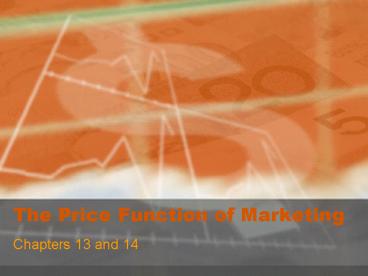The Price Function of Marketing - PowerPoint PPT Presentation
1 / 16
Title:
The Price Function of Marketing
Description:
The money or other considerations exchanged for the ownership or use of a good or service. ... Oligopoly. Monopolistic. Pure Competition. Competitors' price ... – PowerPoint PPT presentation
Number of Views:71
Avg rating:3.0/5.0
Title: The Price Function of Marketing
1
The Price Function of Marketing
- Chapters 13 and 14
2
What is Price
- The money or other considerations exchanged for
the ownership or use of a good or service. - Barter Exchanging goods and services for other
goods and services. - Final Price
- Final Price List Price (Incentives
Allowances) Extra Fees
3
Value and Profit
- Value the ratio of perceived benefits to price.
- Value Pricing Increasing benefits while
maintaining or decreasing price. - Profit Equation
- Profit Total Revenue Total Cost
- Profit (Unit Price x Quantity Sold) Total Cost
or
4
Steps in Setting Price
5
Step 1 Identify Constraints and Objectives
- Constraints factors that limit the price that
firms may set. - Demand
- Newness
- Single product vs. line
- Cost of production
- Cost of changing Price
- Type of competitive market
- Pure Monopoly
- Oligopoly
- Monopolistic
- Pure Competition
- Competitors price
- Objectives expectations that specify the role
of price. - Profit
- Sales or Market Share
- Unit Volume
- Survival
- Social Responsibility
- Customer Satisfaction
6
Step 2 Estimating Demand and Revenue
- The Demand Curve the maximum number of products
consumers will buy at a given price. - Demand Factors
- Consumer tastes
- Price and Availability of other products
- Consumer income
P2
Advertising Campaign
P1
Q1
Q2
7
Step 2 Estimating Demand and Revenuecont.
- Price Elasticity of Demand a measure of the
sensitivity of customers to changes in price. - Elastic Demand a change in price results in a
substantial change in quantity demanded. - computers, furniture
- Inelastic Demand a change in price that has
little or no effect on the quantity that
consumers are willing to buy. - gas, milk
8
Step 3 Determine Cost, Volume, and Profit
Relationships
- Terminology
- Total Cost the total expenses incurred by a
firm in producing and marketing a product. - Fixed Cost expenses that do not fluctuate with
the number of units sold. - Variable Cost expenses that vary directly with
the quantity of products produced.
9
Step 3 Determine Cost, Volume, and Profit
Relationshipscont.
Total Revenue
- Break-Even Analysis
- Break-Even Point the point at which the company
doesnt lose any money and doesnt make a
profit. - BEP
- 4,000 units
Revenue and Cost
Total Cost
Profits
Variable Costs
400,000
Break-Even Point
Losses
200,000
Fixed Costs
Break-Even Quantity
2,000
4,000
6,000
Quantity Demanded
10
Step 3 Determine Cost, Volume, and Profit
Relationshipscont.
- Marginal Cost The increase in total cost that
results from producing one additional unit of a
product. - Marginal Revenue The increase in total income
or revenue that results from selling one
additional unit of a product. - Marginal Analysis
- As long as marginal revenue is greater than
marginal cost, a firm will expand its output of
that product.
11
Step 4 Select an Approximate Price Level
Strategies
- Profit Oriented
- Target Profit
- Target Return on Sales
- Target Return on Investment
- Competition-Oriented
- Customary
- Above-, At-, or Below-Market
- Loss-Leader
- Demand
- Skimming
- Penetration
- Prestige
- Price Lining
- Odd-Even
- Target
- Bundle
- Yield Management Pricing
- Cost-Oriented
- Standard Markup
- Cost-Plus
- Experience Curve
12
Step 5 Set The List or Quoted Price
- One-Price vs. Flexible-Price Policy
- One-Price (Fixed Pricing) Examples?
- Flexible-Price (Dynamic Pricing) Examples?
- Company, Customer, and Competitive Effects
- Company
- Product-Line Pricing
- Customer
- Perception
- Competitive Effects
- Price War
13
Step 5 Set The List or Quoted Pricecont.
- Balancing Incremental Costs and Revenues
- Information
- Advertising Investment 3,465
- Profit Margin 40
- Average Sale 450
- Closing Ratio 65
- Return on Investment 25
- This advertising program will reach over 112,000
listeners ages 12-34 a minimum of 3.0 times. One
out of 3,027 people who hear your ad need to come
in the door.
- (3,465 x (1ROI)) 4,331 Net Return
- 4,331/.40 10,828 Gross Return
- 10,828/450 24 Sales
- 24/.65 37 Customers
- Break-even (0 profit) 30 Customers
- 20 Return (693 profit) 36 Customers
- 30 Return (1,040 profit) 39 Customers
14
Step 6 Make Special Adjustments to the List or
Quoted Price
- Discounts a reduction from the list price given
as a reward. - Quantity Discounts
- Seasonal Discounts
- Trade (Functional) Discounts
- Cash Discounts
- Allowances
- Trade-in Allowances
- Promotional Allowances
15
Step 6 Make Special Adjustments to the List or
Quoted Pricecont.
- Geographical Adjustments
- FOB (free on board)
- Pricing supplier will pay to have product
loaded - Origin Pricing customer pays for transportation
from factory to store - Delivered Pricing Seller pays loading and trans
cost - Uniform Delivered Pricing
- Single-Zone pricing
- Multiple-Zone pricing
- FOB with freight-allowed pricing
- Basing-point pricing
16
Step 6 Make Special Adjustments to the List or
Quoted Pricecont.
- Legal and Regulatory Aspects of Pricing
- Price Fixing Conspiracy among firms to set
prices - Price Discrimination charging different prices
to different customers - Deceptive Pricing bait and switch, conditional
pricing, comparison pricing - Predatory Pricing low prices to drive
competitors out































